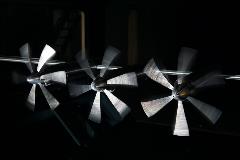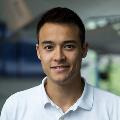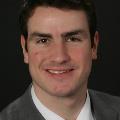Propeller Aerodynamics for Advanced Air Mobility: Fundamentals and Integration Effects

- Course covering the aerodynamics of propellers for aircraft applications, from fundamentals to complex propeller-airframe integration challenges.
- All students will receive an AIAA Certificate of Completion at the end of the course.
Recent developments in the fields of urban air mobility, regional air mobility, (hybrid-) electric propulsion, and sustainable aviation in general have created a renewed interest in propeller propulsion. This course covers the basics of propeller performance up to complex propeller-airframe integration challenges. Participants will be introduced to the basic parameters and physical effects that describe the aerodynamic performance of propellers or rotors. Subsequently, the aerodynamic interaction mechanisms that take place in unconventional configurations such as tip-mounted propellers, boundary-layer ingesting propellers, leading-edge distributed propellers, or rotors in hover or edgewise flight will be discussed. Participants will be shown how these interaction effects vary among the different propeller arrangements, how they affect the aerodynamic and propeller efficiencies of the vehicle, and how they can be modeled with various levels of fidelity.
- Review the latest applications and research areas of propeller propulsion
- Gain an understanding of the basic working principles of (isolated) propeller aerodynamics
- Design a propeller or estimate its performance using non-dimensional parameters and simplified methods
- Learn how the propeller/rotor performance and its modeling differ in the case of hover or edgewise flight
- Understand how propeller/rotor performance affects and is affected by neighboring elements like the wing, fuselage, or adjacent propellers.
- Identify the main aerodynamic interaction effects that occur in unconventional propeller installations, and learn how these effects can influence aircraft efficiency or noise production.
- Distinguish the pros and cons of various types of experimental and numerical propeller modeling techniques
- See detailed outline below
The course is intended for engineers with a background in aerodynamics or aerospace engineering, who want to understand how propellers work, how to model them, or how they affect the performance of the vehicle. A background in propeller aerodynamics is not required.
COURSE INFORMATION
Type of Course: Instructor-Led Short Course
Course Level: Fundamentals - Intermediate
Course Length: 2 days
AIAA CEU's available: Yes
- Introduction (de Vries)
- Historical overview of propeller propulsion
- Advantages & disadvantages of propeller propulsion
- Recent developments - Fundamentals of isolated propellers
- Performance in forward flight (Sinnige)
- How is thrust generated?
- Definition of scaling parameters
- Isolated propeller performance - Actuator disk and blade-element momentum theory (Sinnige)
- Actuator disk theory
- Blade element discretization - Angle-of-attack effects (Sinnige)
- Generation of unsteady blade loading
- Effect on propeller performance - Propeller slipstream (van Arnhem)
- The propeller vortex system
- Steady and unsteady flow features
- Effect of angle-of-attack
- Performance in forward flight (Sinnige)
- Rotors in hover, vertical & edgewise flight
- Hover and vertical flight performance (Rauleder)
- Essential characteristics and parameters such as FM, DL, PL, induced velocity curves, rotor working states
- Factors affecting hovering and vertical flight performance
- Blade design (twist, taper, rotor solidity, planform, etc.) and their effects on hover performance
- Flight in confined environment: ground effect and wall effects - Transition & edgewise flight (Rauleder)
- Aerodynamics of edgewise forward flight
- Forward flight performance: drag synthesis, power requirements, etc.
- Limits in edgewise flight: compressibility effects, retreating blade stall, reverse flow, noise constraints, and what to do about it
- Autorotation - Airframe interaction effects with edgewise/lifting rotors (Rauleder)
- Edgewise rotor interactions with fuselage and wings
- Rotor-rotor interactions
- Hover and vertical flight performance (Rauleder)
- Propeller design & integration effects
- Propeller design and application to aircraft performance (van Arnhem)
- Design: number of blades, chord and twist distributions, pitch setting
- Matching propeller performance maps with the aircraft flight envelope - Fundamentals of propeller–airframe aerodynamic interaction (van Arnhem)
- Effect of non-uniform inflow on propeller performance
- Slipstream impingement phenomena
- Velocity and pressure fields induced by the propeller slipstream - Propeller integration effects in fixed-wing aircraft (de Vries)
- Comparison of configurations: tractor, pusher, tip-mounted, over-the-wing, boundary-layer ingestion
- Effect of distributed propulsion on wing sizing: cruise and high-lift performance
- Effect of distributed propulsion on tail sizing: control, stability, and OEI scenarios
- Propeller design and application to aircraft performance (van Arnhem)
- Propeller modelling methods
- Numerical methods (van Arnhem)
- Recap of lower-order models: ADT, BEMT, panel methods
- CFD propeller modeling approaches: actuator disk, lifting line, full-blade models
- Tips & tricks for numerical simulation of propeller integration effects - Experimental methods (de Vries)
- Measurement techniques for propeller ground and wind-tunnel testing
- Designing the model and test matrix to study propeller integration effects
- Tips & tricks for experimental simulation of propeller integration effects
- Numerical methods (van Arnhem)
- Challenges & Outlook (de Vries)
- Summary
- Challenges that require further research
- Outlook: the need for ultra-efficient propeller systems

Dr. Tomas Sinnige is an assistant professor at the Flight Performance and Propulsion group at Delft University of Technology. His research focuses on rotor-airframe and rotor-rotor aerodynamic and acoustic interactions for future aircraft configurations, with a special focus on experimental analysis of propellers. Previously, he obtained MSc and PhD degrees at the same university, working on the aerodynamics and aeroacoustics of tip-mounted propellers. He has taken part in European projects focused on propeller research. Furthermore, he graduated MSc students on the topic of propeller interactional aerodynamics and aeroacoustics, and published papers in international journals and conferences. In his current role, he is also the responsible lecturer of the MSc course on Experimental Simulations.

Dr. Nando van Arnhem is Aerodynamics Lead Engineer at the start-up company Vaeridion. He is also guest researcher at the Faculty of Aerospace Engineering of Delft University of Technology. Previously, he obtained BSc, MSc, and PhD degrees at the same university. Nando has performed over five years of research in the Clean Sky 2 research framework for regional and large passenger aircraft, where he assessed propeller-installation effects on various aircraft configurations by performing over a dozen wind-tunnel tests, by performing CFD simulations, and by developing lower-order models. Besides his interest in propulsion-integration, Nando has worked on and piloted various scaled-flight demonstrators of novel aircraft configurations.

Dr. Reynard de Vries is Program Manager for New Aircraft Technologies at Panta Holdings, and a visiting researcher at the Faculty of Aerospace Engineering of Delft University of Technology. He obtained a BSc degree in Aerospace Engineering from the Technical University of Madrid in 2014 and subsequently pursued an MSc degree in Aerospace Engineering at Delft University of Technology, which he obtained with distinction in 2016. Reynard has performed five years of research in the European Commission’s Clean Sky 2 framework for large passenger aircraft, where he has worked on conceptual design methods for hybrid-electric aircraft and propeller-wing aerodynamics in distributed-propulsion systems as a part of his PhD research. He has been actively involved in numerous wind-tunnel tests of various (distributed-) propeller configurations and has taught several lectures on hybrid/electric aircraft design. Reynard is a member of the AIAA Electrified Aircraft Technology Technical Committee.

Prof. Juergen Rauleder teaches and conducts research at the School of Aerospace Engineering of the Georgia Institute of Technology. Dr. Rauleder’s research interests are the experimental and applied numerical aerodynamics, with a focus on interactional aerodynamics, coupled aerodynamics with flight dynamics, as well as active, shape-adaptive rotating and fixed wings. His basic research is applied to the aerodynamic design and understanding of current and future vertical lift configurations, including advanced (urban) aerial mobility and UAS, as well as pilot training and simulators. Juergen’s research is sponsored by the U.S. Army, Navy, NASA, ONR, NATO, the EU, and by industry. He received a Masters from the University of Stuttgart and a PhD from the University of Maryland under the guidance of Prof. Gordon Leishman. Juergen serves on the AIAA Applied Aerodynamics Committee, and he is the Chair of the VFS Aerodynamics Technical Committee.
AIAA Training Links
For information, group discounts,
and private course pricing, contact:
Lisa Le, Education Specialist (lisal@aiaa.org)
